Servicios Personalizados
Revista
Articulo
Indicadores
-
 Citado por SciELO
Citado por SciELO
Links relacionados
-
 Similares en
SciELO
Similares en
SciELO
Compartir
Liberabit
versión impresa ISSN 1729-4827
liber. v.19 n.1 Lima ene./jun. 2013
ARTÍCULOS
Predicting academic performance and attrition in undergraduate students
La predicción de rendimiento académico y deserción en estudiantes universitarios
Angela Corengia*, María Pita**, Belén Mesurado*** y Angel Centeno****
* Directora de la Oficina de Evaluación Institucional Universidad Austral, Argentina.
** Universidad Austral - Oficina de Evaluación Institucional, Argentina.
*** CIIPME (Centro Interdisciplinario de Investigaciones en Psicología, Matemática y Experimental - CONICET).
**** Universidad Austral, Argentina.
* acorengia@austral.edu.ar
** MPita@austral.edu.ar
*** mesuradob@gmail.com
**** ACenteno@cas.austral.edu.ar
ABSTRACT
The purpose of this study is to analyze whether educational aptitudes can predict academic performance and attrition. To measure educational aptitudes, the Differential Aptitude Test (DAT) was applied to a nonrandom sample of 1530 firstyear undergraduate students of a private university in Argentina. For the analysis, multiple and logistic regression models were used. The results showed that DAT scores can predict academic performance, but there is a moderate to low relationship between these scores and dropout rates. To summarize, this study is a first step to predict students academic success, in order to save resources and prevent frustration.
Key words: Academic Performance, Attrition, Educational Aptitudes, Higher Education.
RESUMEN
El propósito de este estudio es analizar si las aptitudes educativas pueden predecir el rendimiento académico y la deserción. Para medir las aptitudes educativas se aplicó el Test de Aptitudes Diferenciales (Differential Aptitude Test – DAT) a una muestra no probabilística de 1530 estudiantes de primer año de grado de una universidad privada de la Argentina. Para el análisis se utilizaron modelos de regresión múltiple y logística. Los resultados muestran que el DAT puede predecir el rendimiento académico, mientras que la relación entre el DAT y la deserción es de moderada a baja. Este estudio es un primer paso para predecir el éxito académico de los estudiantes, con el objetivo de ahorrar recursos y evitar la frustración.
Palabras clave: Aptitudes educativas, deserción, educación superior, rendimiento académico.
Introduction
The improvement of educational quality is a matter of concern to all university institutions. Research into quality indicators related to students makes it necessary to develop tools to predict to what extent they are capable to reach a good academic performance, and finish their studies successfully.
There are many factors that can influence students performance, such as personal characteristics, socioeconomic and cultural background, motivation and selfinterests, previous knowledge, and educational aptitudes.
The purpose of this study is to explore the relationship between educational aptitudes and academic performance, in a sample of 1530 first-year undergraduate students from eight different programs (Accounting, Business Economics, Social Communication, Industrial Engineering, Software Engineering, Law, Medicine and Nursing) of a private university in Argentina, in the 2002-2005 period. It also deals with the relationship between educational aptitudes and attrition of this group of students.
In order to get to know educational aptitudes, results of DIFFERENTIALAPTITUDE TEST (DAT) were considered. This test consists of eight subtests that measure different aptitudes. The complete set defines a cognitive profile for each student.
The GRADE POINTAVERAGE (GPA) of the students first academic year was taken as a criterion to measure academic performance.
The hypotheses of this study are:
-
H1: There is an association between the variables «educational aptitudes» [Verbal Reasoning (VR), Abstract Reasoning (RA), Mechanical Reasoning (MR), Spatial Reasoning (SR), Speed & Accuracy (S&A), Spelling (S), Language (L) and Numerical Ability (NA)] and «students academic performance».
-
H2: There is an association between the educational variables «educational aptitudes» [Verbal Reasoning (VR), Abstract Reasoning (RA), Mechanical Reasoning (MR), Spatial Reasoning (SR), Speed & Accuracy (S&A), Spelling (S), Language (L) and Numerical Ability (NA)] and «attrition».
-
H3: There are educational aptitudes that are more strongly associated with academic performance and attrition, according to the different programs.
Theoretical Framework
Several theories have been advanced to explain the university persistence process, primarily focused on two broad models.
In Tintos Student Integration Model (1975), persistence is related to the interactions of the students with the academic institution, not only academically but also socially, referring to integration with mates and professors. In this model, the decision to dropout is much more influenced by the experiences of the student at University than his previous background.
Bean and Metzners Student Attrition Model (1985) emphasizes that within the decision of the student to dropout external variables converge, such as financial factors, job situation, family responsibilities and other kind of factors like motivation, satisfaction and stress.
A study made by Cabrera, Castañeda, Nora and Hengstler (1992) concludes that Tintos and Bean and Metzners theories are complementary. According to these authors, both «context» factors and «academic experience» influence on the students permanence in the university or on his dropping out.
Since then, topics like academic performance and retention have been studied from diverse theoretical and methodological perspectives in order to improve permanence and graduation rates.
In these studies, the aim was to relate academic success with independent variables such as High School characteristics, personal characteristics, Grade Point Average (GPA), and educational aptitudes.
A review and a synthesis of published studies at both national and international level were made, focusing on those studies that include predictions based on standardized test scores evaluating academic aptitude of junior students.
At an international level, a study made by Noble and Sawyer (1997) shows that the students previous academic aptitude, measured by the ACT (American College Testing) and the High School GPA, have sufficient predictive validity as to take them into account in the criteria of selection of the students. Eno, McLaughlin, Sheldon and Brozovsky (1999), studied the academic performance of 12000 students admitted at Virginia Tech University taking into account, besides the results of the SAT (Scholastic Aptitude Test), the High School information, the personal characteristics, the interests of the students and the admission year. The purpose of this study was to create models that allow predicting students performance in the university. Betts and Morell (1999) conducted a research in the University of California, San Diego in order to determine what factors influence the students academic performance, taking into account their personal characteristics and their school of origin as well as their High School GPA and SAT results. Among other matters, they state that such characteristics as well as the school of origin influence the GPA, and that good performances in High School and in SAT results predicts a good performance in university. Pike and Saupe (2002) studied the students performance in their first year of university by analyzing three models in order to predict the students academic performance in first year. A model based on three predictors, the result of standardized tests (ACT), High School grades and high school coursework, a model based on high school characteristics and a model that combines both. The authors conclude that both the second and the third model predict students performanceparticularly those having low performance-better than the first model. At a school of Nursing in Ontario a Canadian version of Differential Aptitude Test (DAT) is applied as a part of admission process. In a research made in function of the results of this test, Taylor (1999) sought to identify academic success predictors to be used as a part of admission requirements, studying the correlation between the DAT results and the first year GPA. Abstract reasoning, verbal reasoning and numerical ability tests were administered to two groups of 150 students admitted in 1991-1992. As a result, moderate correlations between GPA and DAT tests, and a significant correlation between the GPA and the verbal reasoning test, were found.
The evidence shows that the results of the standardized test scores are related to students academic performance, among other indicators, especially during the first year of the undergraduate courses (see Table 1).
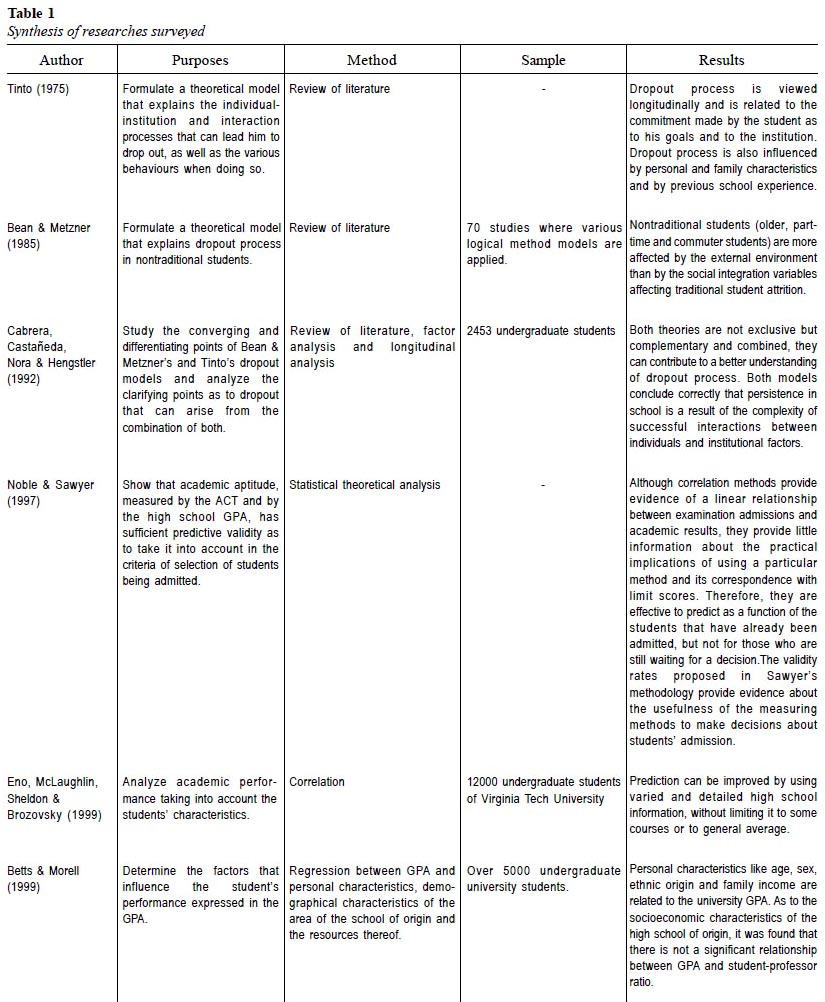
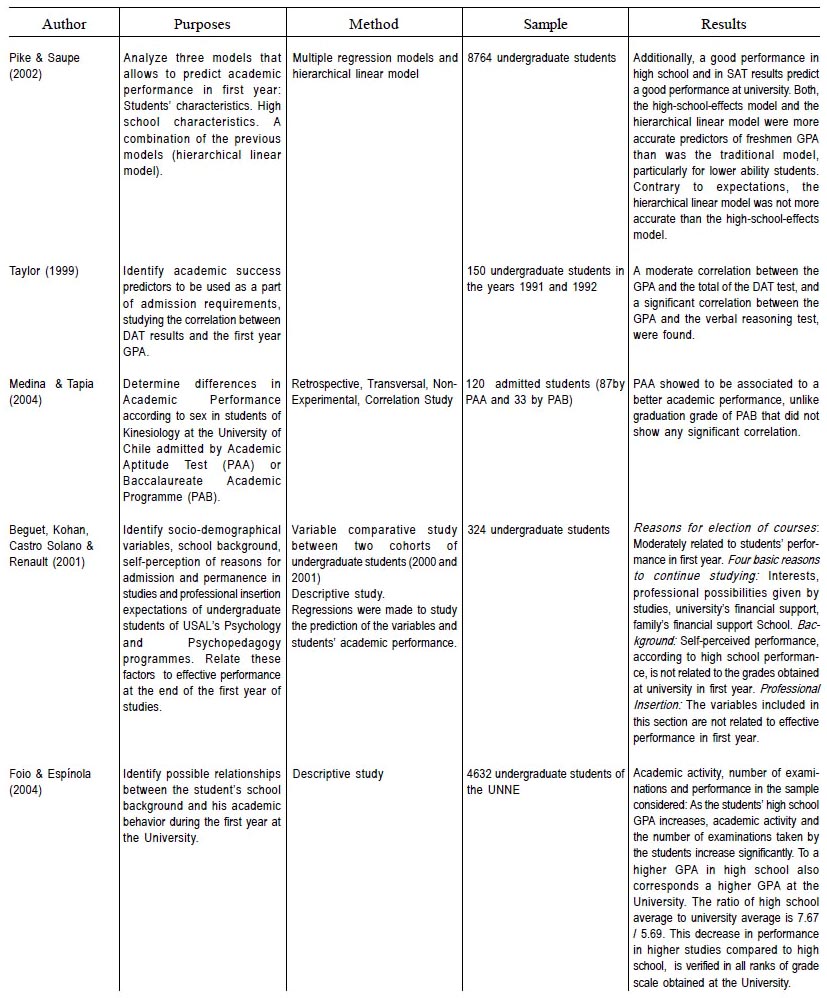
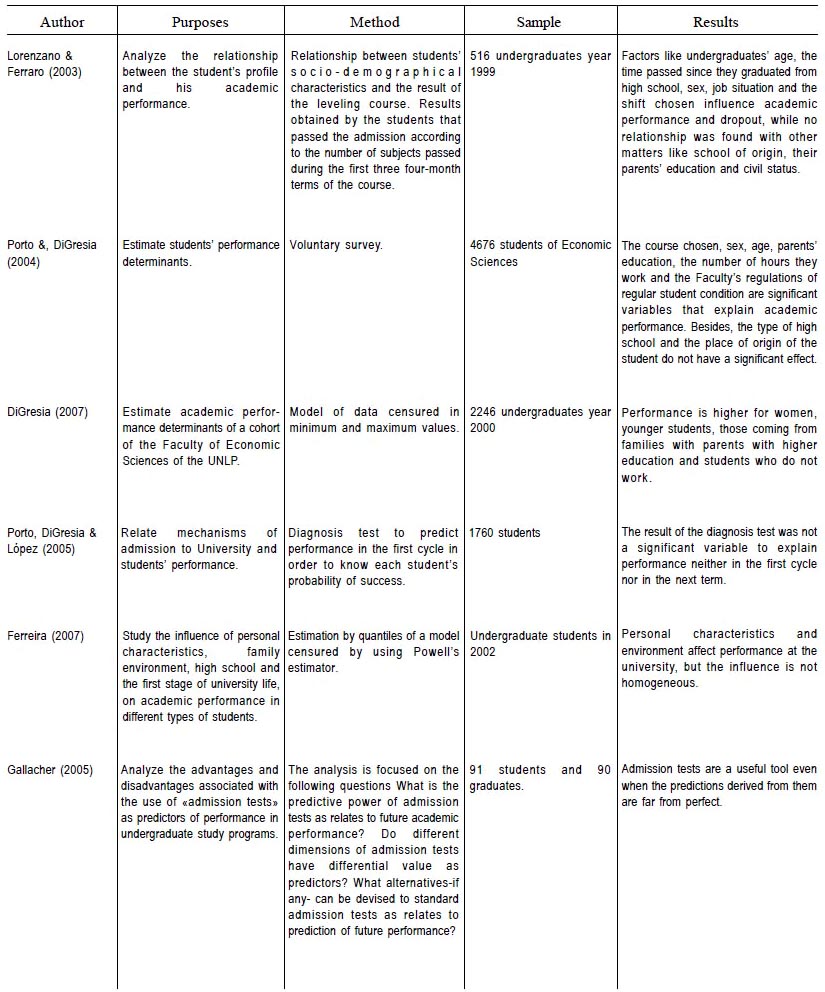
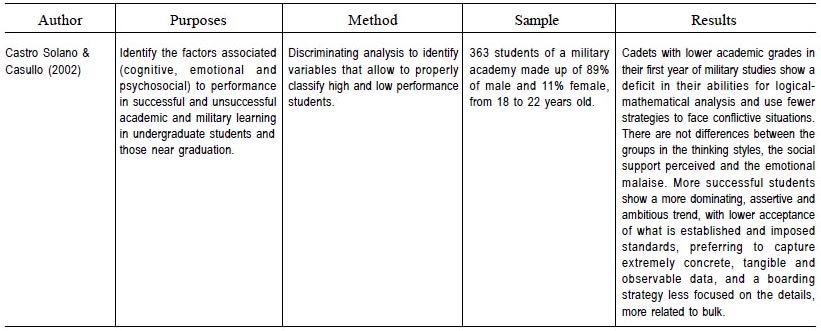
As background in Latin America, we can mention a study taken at the Kinesiology course of the Universidad de Chile (Medina & Tapia, 2004) which seeks to determine the predictive capacity of systems of admission to universities (Academic Aptitude Test -PAA- and Baccalaureate Academic Programmes -PAB-) related to the academic performance of the students of the course, according to the admission system and gender. PAA measures verbal domain and mathematical reasoning aptitudes, whereas several fields of knowledge converge in PAB, leveling knowledge in subjects that shall be the basis for the studies. The results indicate that the students admitted through PAA have a better academic performance than those admitted through PAB. As regards predictive capacity, a more significant correlation was found between PAA and academic performance than between the latter and PAB. It is observed that American universities have been able to use the results of the standardized tests since the students must obligatorily take them in order to apply to a university. In other countries, admission to university is not done through standardized tests but through their own admission criteria, therefore it is more difficult to find researches related to these results. This is the case of Argentine Higher Education, where an admission to a university is left to the criterion of each institution.
In Argentina, like in most Latin-American countries, each universitys admission process has its own standards; then, it is difficult to find studies related to results of standardized tests. However, all institutions share the same concern about the search of indicators that could improve the performance and permanence of undergraduate students at University.
The purpose of most researches is to relate academic performance to the students socio-demographical characteristics.
A study made at the Universidad del Salvador (Beguet, Kohan, Castro Solano & Renault, 2001), analyzes the variables involved in the academic performance of students of Psychology and Psychopedagogy, such as sociodemographical variables, school background, selfperception of the reasons to begin and to continue studying, professional insertion expectations, and their relation to academic performance in the first year of studies. The results show that both the students socio-demographical characteristics and the other variables included in the study are without changes. Regarding the successful academic performance in the first year, it was verified that it is related to the reasons for the choice of a course and to the permanence in the studies. For the other factors no relation was found.
At the Universidad Nacional del Nordeste, a characterization of the socio-educational profile and mentoring was made during the first year of higher studies of 4632 new enrolled students, for the purpose of identifying possible relationships between high school background and their academic performance during the first year of studies at the University. It was concluded that as the students High School GPA increases, academic activity, the number of examinations taken, and the university GPA increase significantly (Foio & Espínola, 2004).
The Universidad Nacional de Tres de Febrero also analyzed the students profile and academic performance. The study describes their socio-demographical characteristics and relates them to the results obtained by the students during the first three terms of their course (Lorenzano & Ferraro, 2003). According to this study, factors such as undergraduate students age, the time that has passed since their graduation from High School, the gender, the job situation and the shift chosen, influence academic performance and attrition, while no relation has been found with other matters such as the school of origin, parents education and civil status.
The Department of Economy of the Faculty of Economic Sciences of the Universidad Nacional de La Plata has developed a large number of studies related to the academic performance of the students at the University. According to one of these studies, the course followed by the student, along with the gender, age, parents education, the number of hours he works and the Facultys regulations are significant variables that explain academic performance, whereas the type of High School and the place where the student comes from have no significant effect thereon (Porto & DiGresia, 2004). In other study it was concluded that women, younger students, those coming from families where parents have a higher education and students who do not work, have a better performance at university (DiGresia, 2007), and that, although personal characteristics and environment affect performance at a university, the influence is not homogeneous (Ferreira, 2007).
Other research at the same Department had the purpose of relating academic performance to other indicators, for example performance at admission. In line with this, the relationship between the mechanisms of admission to university and students performance was analyzed. It was determined that the result of the diagnosis test was not a significant variable to explain performance neither in the first cycle nor in the next term (Porto, DiGresia & López Armengol, 2004). These same authors made another study focused on students progress, after admission. Factors that explain students performance were studied. Two of the main results were that two years after having started studies, 53% of undergraduate students had not passed any subject and that performance in the basic cycle is an important determinant of academic achievements in the next terms.
At the University of the CEMA (Centre of Macroeconomic Studies of Argentina), the advantages and disadvantages associated to the use of «admission tests» as predictors of performance, were analyzed. The research concludes that admission examinations are a valuable tool though the predictions derived from them are far from being perfect (Gallacher, 2005).
A study made at a military academy is also relevant (Castro Solano & Casullo, 2002) as its object was to identify the factors associated to academic and military performance, both of undergraduate students, and of those near graduation. Among others, personality, problem-solving, and intelligence tests were administered. The relationship between some of the variables studied like, aptitude for abstract reasoning, dominating personality style and confrontation strategies focused on problem solving, and academic achievements in first year, was verified, while no relationship arose with social support networks, the psychological welfare perceived or the presence of psychopathological symptoms.
As can be seen, the records found related to the application of standardized tests at Argentine universities are few, but there are signs that the implementation of tests could permit an improvement in making decisions about students performance (Gallacher, 2005).
Castro Solano and Casullo (2002) Identify the factors associated (cognitive, emotional and psychosocial) to performance in successful and unsuccessful academic and military learning in undergraduate students and those near graduation. Discriminating analysis to identify variables that allow to properly classify high and low performance students. 363 students of a military academy made up of 89% of male and 11% female, from 18 to 22 years old.
Cadets with lower academic grades in their first year of military studies show a deficit in their abilities for logicalmathematical analysis and use fewer strategies to face conflictive situations. There are not differences between the groups in the thinking styles, the social support perceived and the emotional malaise. More successful students show a more dominating, assertive and ambitious trend, with lower acceptance of what is established and imposed standards, preferring to capture extremely concrete, tangible and observable data, and a boarding strategy less focused on the details, more related to bulk.
Purpose of the work and basis
The possibility to make an early detection of students that, due to their cognitive profile measured through educational aptitudes, are potentially vulnerable to suffer academic failure and consequent dropout, is a useful instrument that can help to promote mentoring strategies and personalized formation since admission is done.
Although the data of this study is referred to students of one particular university, the number of cases is significant. Obtained results provide empiric evidence to theoretical discussion about this subject.
Methods
It is a study with empirical-observational data
Participants
Consent for this project was obtained at multiple levels. First, heads of the University were asked to discuss the study with the researchers. They were provided with a copy of the research proposal, and the characteristics of the research were explained. Once permission was received from heads of the University, students were clearly told that participation was voluntary, and were informed of the purpose of the study. They were then instructed on data collection procedures, and reminded that they could refuse to answer questions if they chose to. There were no objections from the students.
The nonrandom sample consists of 1530 first-year undergraduate students from eight courses: Accounting, Business Economics, Social Communication, Industrial Engineering, Software Engineering, Law, Medicine and Nursing. Ages range from 17 to 20 years old when being admitted. The socioeconomic level of evaluated students is homogeneous, a majority of them belong to medium and medium-high sectors. The temporal space comprises the cohorts of undergraduate students of first year in the years 2002, 2003, 2004 and 2005.
Instruments
In order to get to know educational aptitudes, results of DAT were considered. This test is applied to junior students in the first weeks after being admitted in a private university in Argentina.
DAT has been widely used worldwide, and it consists of eight subtests that measure different aptitudes: abstract reasoning, verbal reasoning, speed & accuracy, spelling, language (grammar and punctuation), numerical ability (arithmetic), space relations and mechanical reasoning. Each subtest is independent and measures students capacity in each evaluated aptitude. The complete set defines a cognitive profile for each student.
The reasons for which DAT were chosen to apply are based on their validity (capacity of predicting success or future performance in certain activities); reliability (the tests are consistent, the results obtained are stable, free of causal errors) and the independence of the aptitudes measured (the tests denote low intercorrelation). The aptitudes measured for the various tests differ from each other sufficiently as to justify inclusion of all the tests in the series. This is especially satisfactory if it is considered that each test was conceived so that it would have its own validity (Bennett, Seashore, Wesman & Justo, 1999). The usefulness of the DAT is mainly its ability to predict the success or the future performance in certain activities.
As regards the validity of the DAT as a predictor, there are several studies that support it (Lynn, 1992; Nijenhuis, Evers & Mur, 2000; Wang, 1993). Thus, it can be considered that the DAT has, generally, a sufficiently high reliability and a sufficiently low intercorrelation as to be a battery of tests provided with a good capacity with a considerable discriminating power. This instrument showed a good validity in previous Argentinean studies. The Vocational Department of University of Buenos Aires worked on the standardization of DAT tests, generating the first local scale (Bennett et al., 1999).
The Grade Point Average (GPA) of the students first academic year was taken as criterion to measure academic performance.
Procedure
DAT is applied in this university since 1999. In 2004, a first analysis was made with cohorts 1999-2002. In 2006 a new sample was considered with cohorts 2002-2005, in order to elaborate a more rigorous statistical and interdisciplinary study.
Firstly, an exploratory analysis of data was made. For this purpose, graphical techniques like box-plot and numerical techniques like calculation of mean, variance and coefficient of variation, were used.
To identify what are the educational aptitudes related to students academic performance, a general linear model was used (Searle, 1971), wherein the results of the DAT tests were considered the independent variables and the academic performance the dependent variable. The final model was selected using a procedure based on the AIC criterion (Sakamoto, Ishiguro & Kitagawa, 1986) where the parameters selected have a p-value < .05.
Six multiple regressions were constructed to analyze the relationship of each educational aptitude with academic performance, unifying related courses: Business (Accounting and Business Economics), Journalism, (Industrial Engineering and Software Engineering), Law, Medicine and Nursing.
To study the relationship between educational aptitudes and attrition a generalized linear model was applied (McCullagh & Nelder, 1989; Nelder & Wedderburn, 1972) where the results of the DAT tests were considered as the independent variables and the dependent variable being codified as 1 = dropping out student; 0 = not dropping out student. For this analysis high and low performances were considered and whether the student did or did not drop out of the university. It was determined that the results of the DAT were low when the value was lower than the first quartile.
Results
From the regression analysis that relates the results of the DAT to academic performance, an R2 was obtained for each program, showing what percentage of the academic performance variance is explained by the educational aptitudes.
34 % (R2 = .34) of the variance was explained for Nursing, 25% (R2 = .25) for Social Communication and Law, 15% (R2 = .15) for Engineering, 14% (R2 = .14) for Business, and finally, 12% (R2 = .12) for Medicine.
According the best regression model for each course:
The educational aptitudes that related significantly to the academic performance of Nursing students were Verbal Reasoning (VR) and Numerical Ability (NA) (p < . 001), Abstract Reasoning (AR) (p < . 01) and Speed & Accuracy (S & A) (p < . 05).
The educational aptitudes that related significantly to the academic performance of Social Communication students were Verbal Reasoning (VR), Language (L), Spelling (S) and Speed & Accuracy (S & A) (p < .0001), Spatial Reasoning (SR) (p < .001) and Abstract Reasoning (AR) (p < .01).
The educational aptitudes that related significantly to the academic performance of the students of Law were Verbal Reasoning (VR), Language (L) and Spelling (S) (p < .000), Abstract Reasoning (AR) (p < .001), Speed & Accuracy (S & A) (p < .01), and Numerical Ability (NA) and Mechanical Reasoning (MR) (p < .05).
The educational aptitudes that related significantly to the academic performance of the students of the courses of Engineering were Verbal Reasoning (VR) (p < .000), Language (L) and Spelling (S) (p < .001) and Abstract Reasoning (AR), Numerical Ability (NA) and Speed & Accuracy (S & A) (p < .01).
The educational aptitudes that related significantly to the academic performance of the students of the courses of Business were Verbal Reasoning (VR) (p < .0001), Language (L), Spelling (S) and Abstract Reasoning (AR) (p < .01), and Numerical Ability (NA) and Speed & Accuracy (S & A) (p < .05).
The educational aptitudes that related significantly to the academic performance of Medicine students were Verbal Reasoning (VR) and Numerical Ability (NA) (p < .000), Spelling (S) (p < .001), Language (L) (p < .01) and Abstract Reasoning (AR) (p < .05).
The results based on the logistic regression analysis and on the odds ratios -that measure the relationship between the DAT and attrition- for each program are showed in Table 2.
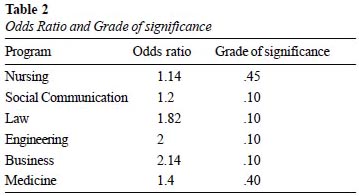
For the students of the program of Business the chance coefficient obtained was 2.14 (this means that a student who obtained a low DAT, is 2.14 times more likely to dropout than not to dropout), for the students of the courses of Engineering, 2; for Law students 1.82; and for Journalism students 1.2. For these courses the coefficient obtained was significant with p = .10
For the Nursing students the chance coefficient obtained was 1.14 and for Medicine students 1.40, though they were not found significant at p = .10 (the grades of significance were p = .45 and p = .40 respectively).
Conclusion
We can conclude that the DAT is an instrument that allows estimating students performance in the first academic year of an undergraduate programs. Also, it makes is possible to predict moderately the chances of attrition in some programs (Business, Engineering, Law and Social Communication), whereas in others (Nursing and Medicine) its prediction capacity is not significantly, in the statistical meaning.
Regardless the program, abstract and verbal reasoning were the best predictors of academic performance. This may be because they evaluate the basic reasoning issues of learning process. Something similar happened with the measurement of language and spelling-subtests that measure students daily vocabulary, grammar and spelling ability, as both subtests were related to student performance, excepting for Nursing students.
Mechanical and spatial reasoning subtests were the least predictors of academic performance in almost every program. It is particularly notable that these tests were unable to predict Engineering students academic performance, as these abilities are considered necessary for a good development in this discipline.
These results differ from the findings of a study carried out by Vázquez and Noriega (2011) who found that spatial reasoning subtest predicts Architecture students academic performance, as this ability is suppose to be related to this discipline. This study also found that students can develop these skills progressively during the program as a result of learning process.
It is necessary to carry out further studies in order to know more about the role that these aptitudes have in academic performance, especially in Engineer programs.
There are, of course, limitations to this short study. Considering that the population enrolled at this university is uniform in age, socio-cultural and economic background, it would be interesting to study the impact of variables such as motivation, engagement, satisfaction and stress, in order to complement this study with the measure of other factors that can influence both academic performance and retention.
However, the DAT scores obtained have allowed designing personalized strategies of mentoring in order to promote good academic performance and to increase retention rates.
References
Bean, J. & Metzner, B. (1985). A conceptual model of nontraditional undergraduate student attrition. Review of Educational Research, 55(4), 485-540.
Beguet, B., Kohan, N., Castro Solano, A. & Renault, G. (2001). Factores que intervienen en el rendimiento académico de los estudiantes de psicología y psicopedagogía. Revista Científica de la Dirección de Evaluación y Acreditación de la Secretaría General de la Universidad del Salvador-USAL I(1), 1-18. Retrieved from http://www.salvador.edu.ar/uc4-pub-01-1-104.htm
Bennett, G., Seashore, H., Wesman, A. & Justo (1999). Tests de aptitudes diferenciales DAT. Manual Forma T. Buenos Aires: Paidós.
Betts, J. & Morell, D. (1999). The determinant of undergraduate grade point average: The relative importance of family background, High School resources, and peer group effects. The Journal of Human Resources, 34(2), 268-293.
Cabrera, A., Castañeda, M., Nora, A. & Hengstler, D. (1992). The convergence between two theories of college persistence. The Journal of Higher Education, 63(2), 143-164.
Castro Solano, A. & Casullo, M. (2002). Predictores del rendimiento académico y militar de cadetes argentinos. Anales de Psicología, 18(2), 257-249.
Di Gresia, L. (2007). Rendimiento académico universitario. Documento de la Universidad Nacional de La Plata. Retrieved from http://www.aaep.org.ar/anales/works/works2007/digresia.pdf
Eno, D., Mclaughlin, G., Sheldon, P. & Brozovsky, P. (1999). Predicting freshman success based on high school record and other measures. AIR Professional File 72, 1-12. Retrieved from http://www3.airweb.org/page.asp?page=73&apppage=85&id=72
Foio, M. & Espínola, A. (2004). Seguimiento académico de los ingresantes 2002. Documentos de la Secretaría de Planificación de la Universidad Nacional del Nordeste. Retrieved from http://eluniversitario.unne.edu.ar/2004/44/pagina/Informe Completo.pdf
Gallacher, M. (2005). Predicting academic performance. Document of Universidad del CEMA. Retrieved from www.ucema.edu.ar/.../documentos/312.pdf
Lorenzano, C. & Ferraro, M. (2003). Perfil de los ingresantes de la Universidad Nacional de Tres de Febrero: rendimiento y posibles causas del fracaso académico. Paper presented at the II National Congress in Educational Research.
Lynn, R. (1992). Sex differences on the differential aptitude test in british and american adolescents. Educational Psychology, 12(2), 101-106.
McCullagh, P. & Nelder, J. (1989). Generalized linear models. London: Chapman and Hall.
Medina, N. & Tapia, A. (2004). La admisión a la carrera de kinesiología de la Universidad de Chile vía bachillerato y vía Prueba de Aptitud Académica: Sistemas de ingreso como predictores del rendimiento académico. Thesis submitted for Kinesiology degree. Facultad de Medicina, Universidad de Chile. Retrieved from http://www.cybertesis.cl/tesis/uchile/2004/medina_n/sources/medina_n.pdf
Nelder, J. & Wedderburn, R. (1972). Generalized linear models. Journal of the Royal Statistical Society, 135, 370-384.
Nijenhuis, J., Evers, A. & Mur, J. (2000). Validity of the differential aptitude test for the assessment of immigrant children. Educational Psychology, 20(1), 99-115.
Noble, J. & Sawyer, R. (1997). Alternative methods for validating admissions and course placement criteria, AIR Professional File 63, 1-12. Retrieved in http://www3.airweb.org/page.asp?page=73&apppage=85&id=63
Pike, G. & Saupe, J. (2002). Does high school matter? An analysis of three methods of predicting first-year grades. Research in Higher Education, 43(2), 187-207.
Porto, A. & Di Gresia, L. (2004). Rendimiento de estudiantes universitarios y sus determinantes. Revista de Economía y Estadística XLII, 94-113.
Porto, A., Di Gresia, L. & López, M. (2004). Admisión a la universidad y rendimiento de los estudiantes. Paper presented in the XXXIX Annual Meeting of AAEP, Universidad Católica Argentina.
Sakamoto, Y., Ishiguro, M. & Kitagawa, G. (1986). Akaike Information Criterion Statistics. Dordlecht/Tokyo: D-Reidel Publishing Company.
Searle, S. (1971). Linear Models. New York: J. Willey & Sons.
Taylor, R. (1999). Correlations between Differential Aptitude Test (DAT) scores and grade point average (GPA) for firstyear community college nursing students. Thesis submitted to the Faculty of D Youville College School of Health and Human Services for the degree of MSc in Community Nursing. Retrieved in http://proquest.umi.com/dissertations/preview_all/1395719
Tinto, V. (1975). Dropout of higher education. A theoretical synthesis of recent research. Review of Educational Research, 45(1), 89-125.
Vázquez, S. & Noriega, M. (2011). Razonamiento espacial y rendimiento académico. Interdisciplinaria, 28(1), 145-158.
Wang, L. (1993). The Differential Aptitude Test: A review and critique. Paper presented at the Annual Meeting of the Southwest Educational Research Association.
Acknowledgements: This study was realized with the support of the Direction of Research of Universidad Austral.
Recibido: 30 de noviembre de 2011
Aceptado: 03 de setiembre de 2012













